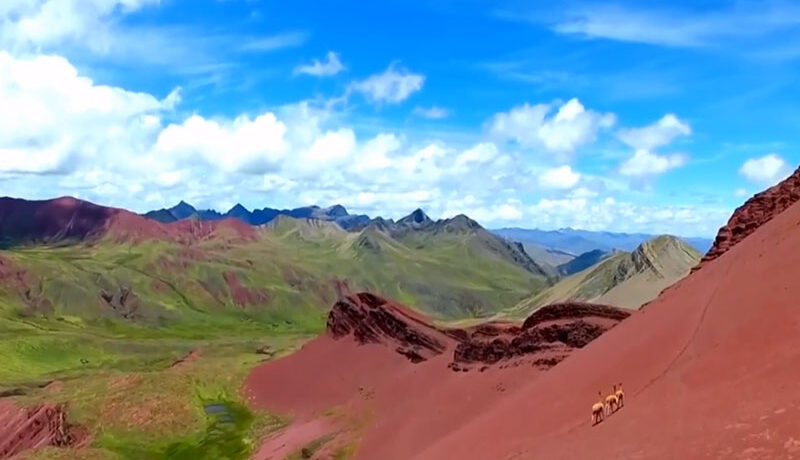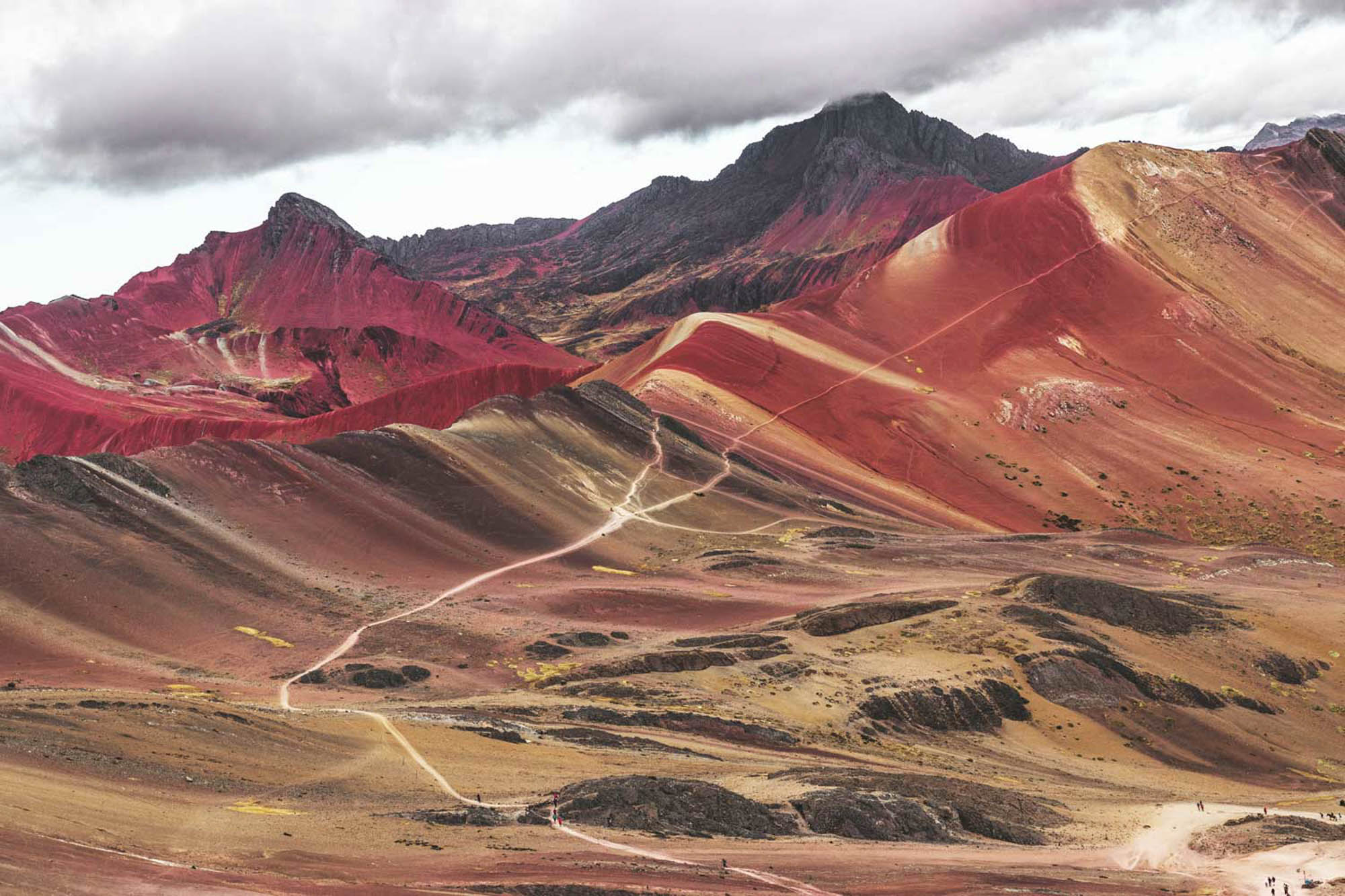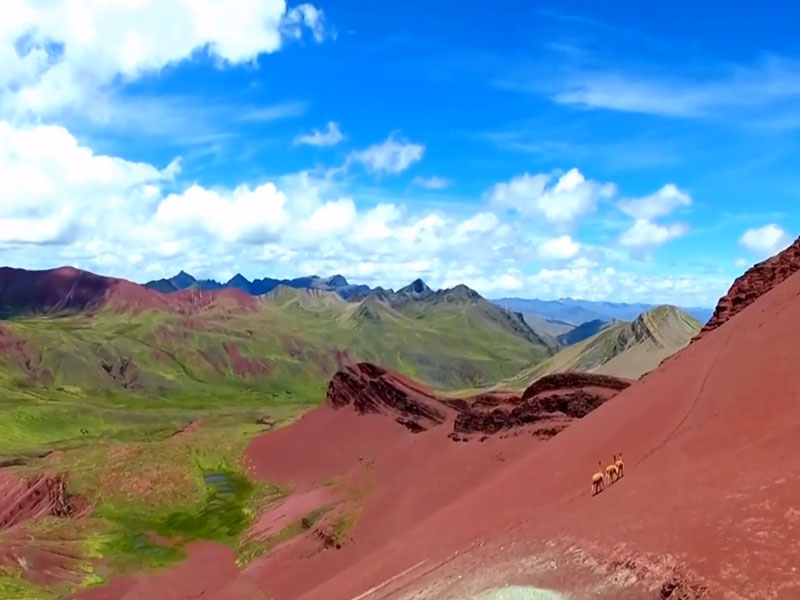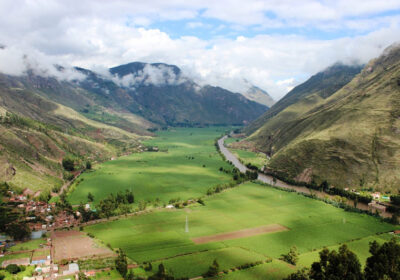
Discover the Red Valley of Cusco, the land of fire and pure air
Welcome to the Red Valley! Embark on this adventure and discover a whole new world within Cusco. Prepare to witness one of Peru’s most stunning landscapes.
Table Of Content
- Uncover the origins and secrets of Cusco’s Red Valley
- What is the Red Valley?
- What makes the Red Valley of Cusco so special?
- Why is it red?
- Where is the Red Valley located?
- What is the altitude of the Red Valley?
- How to Get to the Red Valley from Cusco
- On your own.
- Through an organized tour
- From Rainbow Mountain (Vinicunca)
- History of the Red Valley in Cusco
- The geological origin of the Red Valley of Cusco
- The Secrets of the Red Valley in Cusco
- The Red Valley is an ancestral route between the mountains, the jungle, and the sky
- It is a place steeped in culture
- Travel Tips
Many tourists know Rainbow Mountain, also known as Vinicunca, for its diverse hues. What they don’t know is that a beautiful valley nearby stands out for its vibrant reddish color, seemingly straight out of another planet.
This surprising place has gained popularity in recent years but remains a lesser-known destination where you can enjoy peaceful hikes with fantastic views. Both the Red Valley and Rainbow Mountain are unique places where spectacular views have been created by several geological phenomena. They are so close to each other that you can visit them in one day.
Uncover the origins and secrets of Cusco’s Red Valley
This stunning landscape offers more than just breathtaking views. It connects you with ancient Inca trails, villages that have retained their traditional ways of life, and mountains that appear as if painted by time itself. Every part of it reveals something new, from its scarlet color to the history hidden beneath the ice. If you’re planning a trip to Cusco, we’ll explain how to visit the Red Valley, whether with or without a tour. We’ll also tell you the best time of year to go and how to avoid unnecessary expenses. Are you ready for this experience?
What is the Red Valley?
It is a nearly flat, winding valley surrounded by mountains that create a unique landscape. Formed by the Ausangate glaciation, the valley preserves ancient traces in every corner. Locals call it Puka Pampa, meaning “red plain” in Quechua. The reddish earth undoubtedly makes it a striking place at first glance.
What makes the Red Valley of Cusco so special?
Its intense reddish hue clearly differentiates it from other colorful valleys in Peru. Its value is not only natural; it is also part of the ancient Inca pilgrimage route to Apu Ausangate. Important ceremonies were held there for centuries. Today, its proximity to Vinicunca Mountain makes it a must-see destination.
Why is it red?
The valley’s red color is no coincidence; it comes from the oxidation of minerals that settled in the area over millions of years. This natural process has been made possible by the passage of time and the unique conditions of the Andean soil. Each section therefore reflects a surprising geological history. Walking through it provides an understanding of how the earth transforms.
Where is the Red Valley located?
It is a beautiful, reddish terrain surrounded by hills in the Andes region that could easily be Mars.
It is just a 30-minute walk from Vinicunca Rainbow Mountain, and visitors access both sites via the same route. The Red Valley is located in the Pitumarca district of the Canchis province, about 100 km southeast of Cusco. It takes about a three-hour drive from Cusco to the starting point of the hike.
What is the altitude of the Red Valley?
Located at 5,050 meters (16,568 feet) above sea level, the hike is more demanding due to the physical effort required to walk at this altitude. Therefore, we recommend spending some time in Cusco (11,155 feet/3,400 meters) to acclimatize before beginning the hike.
The area is also home to Ausangate, a snow-capped mountain and the highest peak in the Cusco region at 6,372 meters (20,905 feet). The Incas considered it an apu, or sacred mountain, and during the hike to the valley, you can see its white peak.
The territory boasts a beautiful, colorful landscape that will stimulate all your senses and show you the best of the Andes. What more could you ask for?
How to Get to the Red Valley from Cusco:
On your own.
From Cusco, head to the bus terminal on Huayruropata Avenue and take a bus to Sicuani. Get off in Pitumarca after a two-hour trip, which costs between 10 and 15 soles. From there, take a bus to the community of Japura for between 20 and 30 soles. Then, begin a one- to two-hour hike to the valley. This route, in addition to being economical, is the most popular among travelers.
Through an organized tour:
Several agencies in Cusco organize excursions to the Red Valley that include transportation, a guide, and food. By choosing this option, you can travel with peace of mind from the start. You’ll also enjoy additional benefits that will make your experience much more complete.
From Rainbow Mountain (Vinicunca)
When you reach the top of Rainbow Mountain, you can continue your journey to the Red Valley without complications. Just take the marked trail there and continue walking. The journey is short, about 20 to 30 minutes. That’s why many travelers choose to visit both places on the same day.
During the tour, there will be a stop to pay the entrance fee for the Rainbow Mountain area since the trail crosses community-owned land. The price varies by season, but the approximate rates are as follows:
Foreign tourists: Between 20 and 25 soles.
National tourists (Peruvians): 10 to 15 soles.
It’s important to note that an additional entrance fee of 10 soles is required to visit the Red Valley and must be paid to the local community.
History of the Red Valley in Cusco
The wonders of climate!
Did you know that the Red Valley of Cusco is located in the Vilcanota mountain range, close to the snow-capped Ausangate mountain, which is the fifth highest in Peru? Originally, this area was a natural freshwater reserve. Over time, however, melting ice revealed its intense reddish color, which had been hidden beneath ice and snow. Today, this erosive valley shows how climate change is changing the Andean landscape.
The geological origin of the Red Valley of Cusco
It dates back to ancient geological formations called the Vilquechico-Inferior and the Muni, which formed millions of years ago during the early Paleocene epoch. First, a base of dark red quartzose and arkosic sandstones formed. Later, layers of fine siltstone, quartz, calcite, and hematite were added, intensifying its color further.
The Secrets of the Red Valley in Cusco
The striking red color of its soil is no coincidence. This hue forms in shallow environments where the oxidation of minerals like iron and manganese gradually changes the earth’s composition over time. The valley’s soil consists of sandstone, quartz, silt, shale, and limestone. With every step you take, the landscape of the Red Valley reveals its rich history.
The Red Valley is an ancestral route between the mountains, the jungle, and the sky
In ancient times, the Red Valley connected not only landscapes, but also stories. It was part of a heavily traveled trade route between the mountains and the jungle, used by local inhabitants who traveled to Paucartambo to exchange goods. The valley was also part of the sacred path followed by the Incas on their pilgrimage to Apu Ausangate. According to tradition, souls crossed this valley before reaching the Red River and ascending the snow-capped mountains to purify themselves. Priests traveled through the valley to offer sacrifices and pray for abundant water for the nearby fields.
Today, the Red Valley is part of a new tourist route connecting the Rainbow Mountains and the snow-capped Ausangate mountain. An increasing number of travelers, both Peruvian and foreign, are taking this route to experience its natural beauty and the challenges it offers to trekking enthusiasts.
It is a place steeped in culture
A visit to the Red Valley of Cusco allows you to admire its unique landscape and better understand the life and customs of the local people.
This area of great cultural value is home to local Andean communities that maintain ancestral traditions and a strong connection to the land. Pachamama, the goddess of the earth, plays a significant role in the daily lives of the locals, as they depend heavily on agriculture and livestock. Pachamama is essential to harvesting crops, so the connection with the natural environment is fundamental.
Llamas and alpacas are also common, as these animals are characteristic of the area and provide many benefits to the local population. Their wool is some of the finest in the world, used to make high-quality clothing that contributes to the Andean communities’ economy. Furthermore, llama and alpaca meat are very healthy and rich in nutrients. If you love food and want to discover new flavors, try this delicious meat at the top of Rainbow Mountain, where some locals prepare it.
Another characteristic of these communities is their Quechua heritage. In addition to the ancient and still-very-present Quechua language, the culture of these communities is characterized by the richness of their ancestral customs. The inhabitants of this area often wear traditional clothing with striking and beautiful colors, similar to those in the Red Valley and at Rainbow Mountain. Men wear ponchos and hats adorned with elements that are characteristic of their community. Women wear skirts with unique designs and colors.
All of this makes an experience in the Red Valley a once-in-a-lifetime event. We invite you to discover the best of Cusco and Peruvian culture in this wonderful place.
Travel Tips:
The Red Valley hike takes place at an altitude to which many travelers are not accustomed. For this reason, we offer helpful tips to make the hike easier.
Prior acclimatization: The Red Valley is located over 5,000 meters (16,404 feet) above sea level, so it is essential to spend a few days in Cusco beforehand to acclimatize and reduce the risk of altitude sickness.
Appropriate clothing: The weather in the Andes can be unpredictable and change throughout the day. Bring layers to adjust to the different temperatures, as well as a raincoat.
Comfortable and sturdy footwear: The hike includes uphill and downhill sections on rocky, slippery terrain. It is important to wear waterproof hiking shoes with good traction.
Sun protection: The sun’s rays are very intense at high altitudes. Bring sunscreen, a cap or hat, and sunglasses.
Water and snacks: The altitude can cause rapid dehydration, so be sure to bring enough water for the hike. It’s also a good idea to bring energy-boosting foods to maintain your strength.
Hiking poles: These are useful for descents because the terrain can be slippery.
Trash bags: Out of respect for nature and the local community, please do not leave trash along the trail.
“Rainbow Mountain in Peru is a breathtaking natural wonder, known for its vibrant, colorful stripes that look like they’ve been painted by nature itself.”










No Comment! Be the first one.